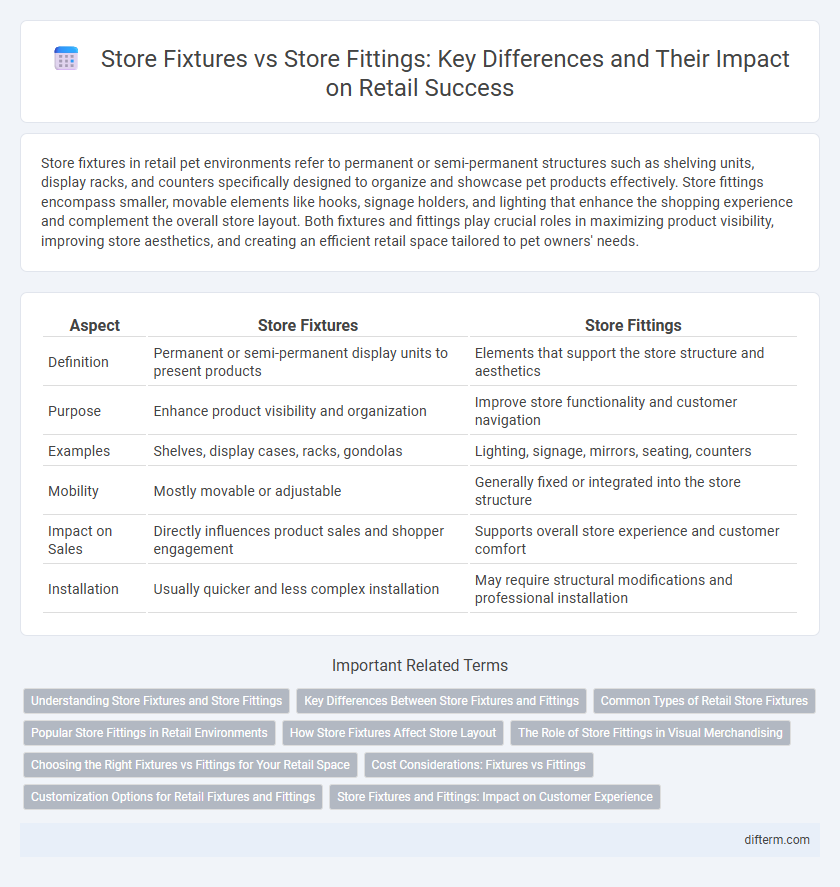Store fixtures in retail pet environments refer to permanent or semi-permanent structures such as shelving units, display racks, and counters specifically designed to organize and showcase pet products effectively. Store fittings encompass smaller, movable elements like hooks, signage holders, and lighting that enhance the shopping experience and complement the overall store layout. Both fixtures and fittings play crucial roles in maximizing product visibility, improving store aesthetics, and creating an efficient retail space tailored to pet owners' needs.
Table of Comparison
| Aspect | Store Fixtures | Store Fittings |
|---|---|---|
| Definition | Permanent or semi-permanent display units to present products | Elements that support the store structure and aesthetics |
| Purpose | Enhance product visibility and organization | Improve store functionality and customer navigation |
| Examples | Shelves, display cases, racks, gondolas | Lighting, signage, mirrors, seating, counters |
| Mobility | Mostly movable or adjustable | Generally fixed or integrated into the store structure |
| Impact on Sales | Directly influences product sales and shopper engagement | Supports overall store experience and customer comfort |
| Installation | Usually quicker and less complex installation | May require structural modifications and professional installation |
Understanding Store Fixtures and Store Fittings
Store fixtures are the durable, movable or fixed elements such as shelving, display cases, and racks used to showcase merchandise and organize retail space efficiently. Store fittings refer to the smaller, often decorative items like signage, lighting, hooks, and mirrors that enhance the store's appearance and functionality. Proper understanding of store fixtures and fittings ensures optimal store layout, improves customer experience, and maximizes product visibility.
Key Differences Between Store Fixtures and Fittings
Store fixtures refer to permanent or semi-permanent elements such as shelving units, display cases, and counters designed to organize and showcase merchandise effectively. Store fittings are smaller, movable accessories like hooks, hangers, and lighting fixtures that enhance the store's functionality and aesthetic appeal. The key difference lies in fixtures being structural components integral to the store layout, while fittings provide flexible, decorative, and functional support within that framework.
Common Types of Retail Store Fixtures
Retail store fixtures include essential elements such as shelving units, display racks, and mannequins designed to showcase products effectively. Common types consist of gondola shelving for versatile product arrangement, gridwall panels for flexible display options, and slatwall systems that allow easy accessory attachment. These fixtures enhance customer experience by organizing merchandise, improving store layout, and maximizing sales potential.
Popular Store Fittings in Retail Environments
Popular store fittings in retail environments include shelving units, display racks, and mannequins, which enhance product visibility and customer experience. These fittings contribute to effective space utilization and support merchandising strategies by creating organized and attractive displays. High-quality materials and ergonomic designs in store fittings improve durability and ease of maintenance, driving long-term retail success.
How Store Fixtures Affect Store Layout
Store fixtures play a crucial role in shaping the store layout by defining product placement and customer flow, which directly influences the shopping experience and sales performance. Effective use of fixtures such as shelving units, display cases, and gondolas maximizes floor space and creates focal points that attract customer attention to key merchandise. Optimizing store fixtures enhances visibility, accessibility, and organization, driving increased customer engagement and boosting overall retail profitability.
The Role of Store Fittings in Visual Merchandising
Store fittings play a crucial role in visual merchandising by enhancing product display and customer engagement within retail environments. These elements, including shelves, racks, and lighting, create an inviting atmosphere that guides shopper behavior and highlights key merchandise. Optimizing store fittings can increase sales by improving accessibility and emphasizing brand aesthetics.
Choosing the Right Fixtures vs Fittings for Your Retail Space
Choosing the right store fixtures versus store fittings is crucial for optimizing retail space functionality and enhancing customer experience. Store fixtures, such as shelving units, display cases, and mannequins, provide essential structure for product presentation, while store fittings, including lighting, signage, and security systems, support ambiance and operational efficiency. Prioritizing durable, modular fixtures combined with adaptable fittings tailored to your merchandise type and store layout drives increased sales and brand alignment.
Cost Considerations: Fixtures vs Fittings
Store fixtures typically involve higher upfront costs due to their permanent nature and custom designs essential for brand identity and product display optimization. Store fittings, being more modular and flexible elements like shelving or lighting, generally incur lower installation and maintenance expenses. Evaluating long-term durability and adaptability helps retailers balance initial investment with operational efficiency and cost-effectiveness.
Customization Options for Retail Fixtures and Fittings
Custom retail fixtures offer extensive customization options, including adjustable shelving, modular designs, and integrated lighting, enhancing product visibility and shopper engagement. Store fittings, such as display racks and wall units, can be tailored with various materials, finishes, and branding elements to create a cohesive store aesthetic. Leveraging bespoke fixtures and fittings enables retailers to optimize space utilization and reinforce brand identity effectively.
Store Fixtures and Fittings: Impact on Customer Experience
Store fixtures and fittings play a crucial role in shaping the customer experience by enhancing product visibility and facilitating ease of navigation within retail spaces. Effective store fixtures maximize merchandise presentation and accessibility, while well-designed fittings contribute to an inviting and comfortable atmosphere that encourages longer browsing times. Optimizing these elements directly influences customer satisfaction, engagement, and ultimately, sales performance.
Store Fixtures vs Store Fittings Infographic

 difterm.com
difterm.com